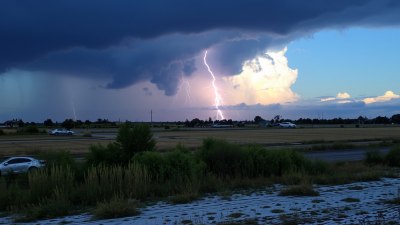What Causes the Sudden Drop in Temperature Before Rain
Explore the science behind the sudden temperature drop before rain and its effects on weather patterns and daily life.

Image created with Flux Schnell
Before a rainstorm begins, many people notice a rapid and sometimes dramatic drop in temperature. This curious phenomenon, which often catches people off guard, is not just a random occurrence but a result of several atmospheric processes working together. Understanding what causes this sudden temperature drop before rain provides insight into the complex dynamics of weather systems and can help anyone better anticipate changes in the environment.
The sudden temperature drop before rain typically results from the interaction between cold air masses, evaporation cooling, and cloud cover effects. These factors combine to cool the surface environment noticeably and quickly, setting the stage for rainfall. Weather enthusiasts and experts alike often observe these changes as heralds of an oncoming storm.
Role of Evaporation Cooling
One of the key contributors to the rapid temperature decrease before rainfall is evaporation cooling. As rain begins to fall, some of the raindrops evaporate while descending through the dry air beneath the cloud base. This evaporation requires heat energy, which is absorbed from the surrounding air, thus lowering the air temperature.
Imagine a hot summer day when a sudden breeze feels refreshing. That is the same principle at work here — evaporation extracts heat from the air, reducing its temperature. This cooling effect is especially pronounced in environments where the air below the cloud base is relatively dry. The drier the air, the more evaporation occurs, leading to a more significant temperature drop.
Downdrafts and Cold Air Advection
Another critical factor is the downdraft associated with falling raindrops. As precipitation forms within clouds, it drags colder air downward, sending a rush of cooler air toward the surface. This air, often descending at high speeds, replaces the warmer air near the ground, causing a rapid decrease in temperature.
These downdrafts occur because rain-cooled air is denser and heavier than the surrounding warmer air, so gravity pulls it down. When this cooler air reaches the surface, it spreads out, creating what meteorologists call a 'gust front' or outflow boundary, which can be felt as a sudden breeze accompanied by a temperature drop.
The Influence of Cloud Cover
Cloud cover plays a significant role in moderating temperatures before rain. Clouds block direct sunlight from reaching the earth, which reduces solar radiation and lowers the ground temperature. Especially when thick, low-hanging rain clouds dominate the sky, they act like a giant umbrella, shading the surface and preventing daytime warming.
The lowering of temperature due to cloud cover is often gradual but can combine effectively with the immediate effects of evaporation cooling and downdrafts to produce the sharp, noticeable drop in temperature people experience before it rains.
Impact of Cold Fronts
Many rain events are associated with cold fronts, where a mass of cooler air pushes into warmer air. When a cold front moves in, it lifts the warm air ahead of it, causing moisture to condense and precipitation to develop. The arrival of this colder air mass causes the temperature to drop suddenly, often well before the rain actually starts.
Thus, the temperature drop can be a direct result of the advancing front rather than the rain itself. This displacement of warm air by cold air leads to a characteristic pattern often used by meteorologists to predict the onset of rain.
Temperature Drops in Thunderstorms
Thunderstorms frequently produce the most dramatic temperature changes before rain. These storms create powerful downdrafts composed of cold air and rain-cooled air rushing downward. As this air reaches the surface, it displaces warmer air and leads to temperature drops that can be felt sharply within minutes.
Gusty winds often accompany these temperature drops due to the spreading out of the cold air upon touching the ground. This is why you might notice a brief burst of cool wind just before the heavy rain begins during a thunderstorm.
Geographic and Seasonal Factors
The extent and intensity of temperature drops before rain can vary widely depending on geographic location and seasonal conditions. In coastal regions, the presence of large bodies of water can moderate temperature variations, leading to smaller drops. Inland areas, especially those prone to dry conditions, can experience more pronounced cooling due to evaporation.
Seasonal variations also influence this phenomenon. During summer, when the air tends to be warmer and often drier near the surface, the cooling effect before rain can feel more striking. In contrast, winter rainstorms might not produce as sudden or sharp a temperature drop because the air is already cooler and humidity levels are higher.
The Role of Humidity
Humidity levels directly impact how much evaporation occurs before rain reaches the ground. In low-humidity environments, more raindrops evaporate, which enhances the cooling effect. Conversely, high humidity means the air is nearly saturated with moisture, so less evaporation happens, and temperature drops might be less noticeable.
This interaction between humidity and evaporation cooling explains why deserts or arid regions can experience a more dramatic temperature decline just before rainfall, as dry air absorbs more latent heat during evaporation.
Effects on Local Weather and Environment
The sudden drop in temperature before rain has several broader effects on local weather and the environment. For one, it can influence wind patterns, as cooler air masses spread out, altering airflow locally. These wind changes can impact everything from pollination to fire behavior in wildland areas.
Moreover, cooler surface temperatures before rain can affect human comfort and health. Rapid cooling might reduce heat stress in hot climates but could also cause discomfort or even hypothermia if temperatures fall too quickly, particularly in vulnerable populations.
Practical Significance for Weather Forecasting
Recognizing the temperature drop before rain is valuable for weather forecasting and prediction. Meteorologists monitor temperature trends alongside humidity, wind patterns, and pressure changes to anticipate rainfall timing and intensity more accurately.
The rapid temperature decline serves as a useful indicator of moisture presence in the atmosphere and the approach of a precipitation event. When combined with other meteorological data, it helps improve forecasts, giving people more reliable information to prepare for changing weather.
Understanding Personal Experience of Temperature Changes
For many, the sensation of temperature dropping before rain is a familiar and often surprisingly fast event. This personal experience can be explained by the combined effects discussed above: evaporative cooling, downdrafts bringing cold air down, cloud cover blocking the sun, and the movement of cold fronts.
Learning about these causes can help people better interpret weather changes they feel in their daily lives and anticipate natural events like rain or storms. It also highlights the complexity of the atmosphere and how various physical processes interact to shape what we perceive as weather.
Summary of Causes
In summary, the sudden drop in temperature before rain is caused predominantly by evaporation cooling of raindrops, where heat is absorbed from the air during evaporation; downdrafts that bring cooler air from higher in the atmosphere down to the surface; cloud cover blocking sunlight and preventing daytime warming; and the arrival of a cold front pushing cold air into warmer regions.
Humidity levels and geographic factors modulate the extent of this temperature drop, making it more or less noticeable depending on location and conditions. Thunderstorms produce particularly dramatic temperature declines due to intense downdrafts and rain cooling.
Understanding these processes is useful not just for meteorologists but for anyone looking to interpret weather signals in their environment.
FAQ
Why does it feel cooler just before rain? The cooling is caused by evaporation of raindrops and cooler air being pushed to the ground by downdrafts, lowering the air temperature.
Is this temperature drop always significant? No, the drop varies depending on humidity, geography, season, and type of rain event. Sometimes it is subtle, other times very noticeable.
Can the temperature drop before rain predict storm intensity? Often, sharper drops in temperature signal stronger downdrafts and potentially more severe storms like thunderstorms.
Does this cooling happen before every type of rain? It happens most noticeably before rain associated with cold fronts and thunderstorms but less so during gentle, warm drizzle where evaporation and downdrafts are minimal.
How can knowing about this help me? Observing rapid temperature drops can give you an early warning of approaching rain, allowing better planning for outdoor activities or travel.











